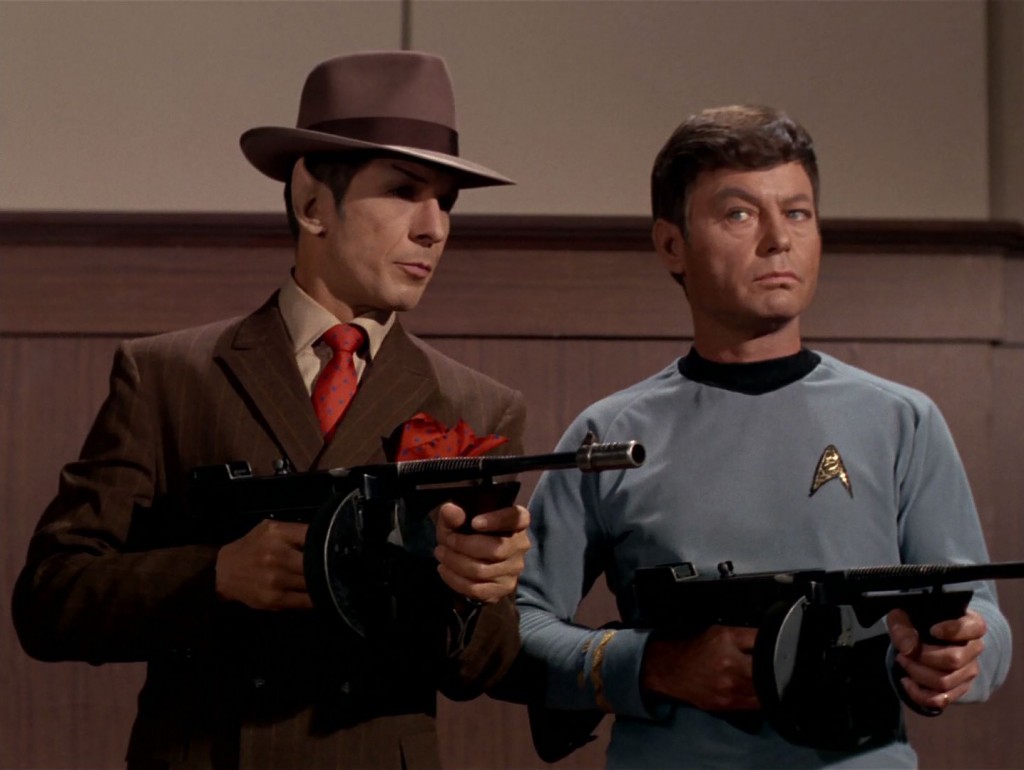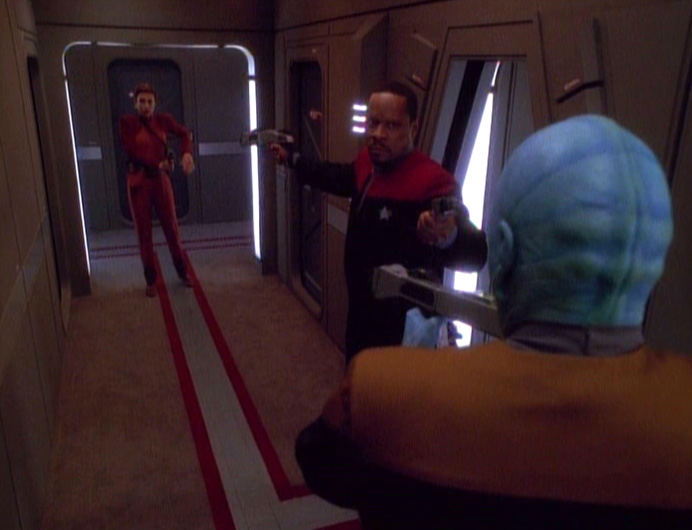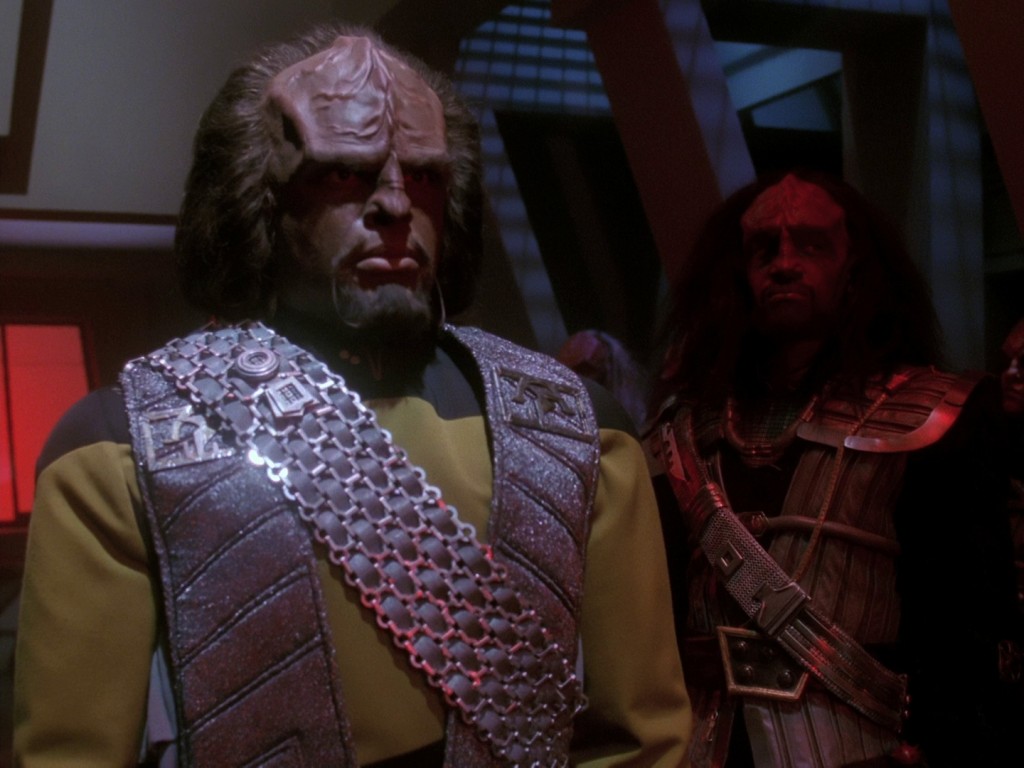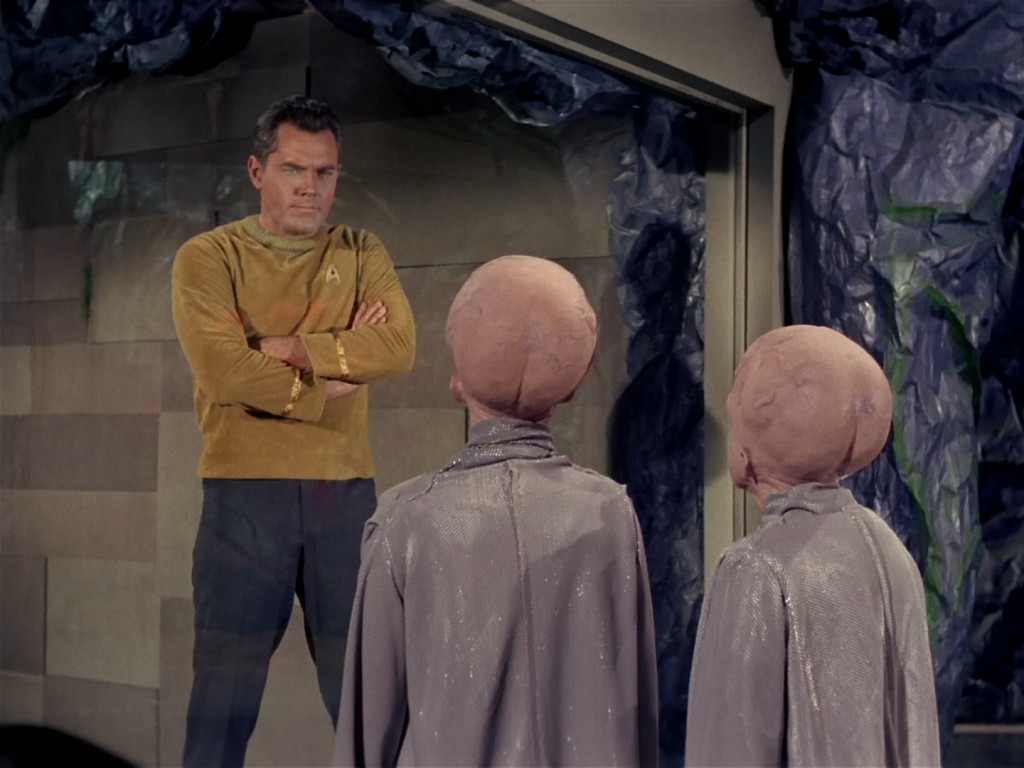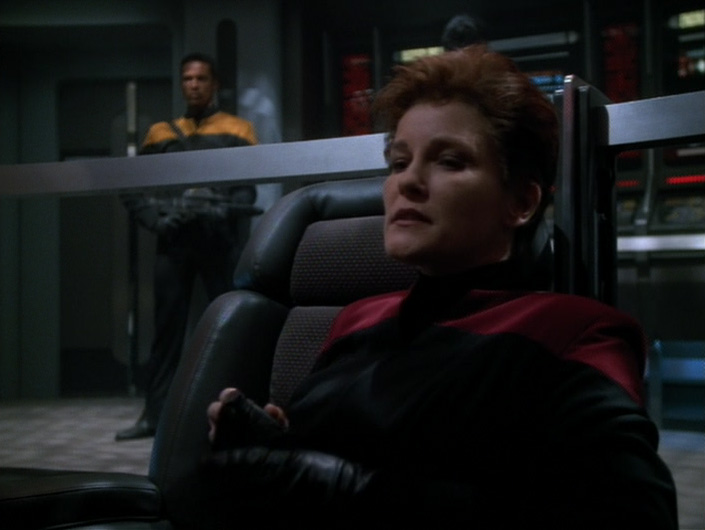On September 8th, 2016, the Star Trek franchise will officially turn 50, and what better way to celebrate than to count down the 50 greatest Star Trek stories in the canon? Deadshirt Founder and Editor Emeritus Dylan Roth pored through the 728 episodes and films to select the Top 50 Star Trek Voyages.
#45: “A Piece of the Action”
Star Trek
Season Two, Episode Twenty
Originally aired January 12, 1968
Teleplay by David P. Harmon & Gene L. Coon
Story by David P. Harmon
Directed by James Komack
Star Trek is admired most for its optimistic vision of the future and the way it excites viewers to get involved in science and social issues. But there’s another side to classic Trek—the side that is incredibly silly. While there are many episodes that are funny by accident due to poor production value or ill-conceived plotlines, there are a number of Star Trek episodes that are just straight-up farce. “A Piece of the Action” is an absurd comedy that works because everyone involved is aware of how ridiculous the story is, even the characters themselves.
The Enterprise visits Sigma Iotia II, where another Earth ship was reported missing about a century earlier. When Kirk, Spock, and McCoy beam down, they discover that, thanks to the last visitors accidentally leaving a book behind on the planet, the Iotians have completely changed their culture, remodeling their society to resemble a cartoonish caricature of the 1920s Chicago mob. Instead of states led by governments, there are “territories” run by bosses and their lieutenants. Everyone dresses in pinstripe suits or gaudy dresses, everyone talks like a Cagney movie, and everyone, everyone is packing heat.
One territory’s leader, Boss Bela Oxmyx (Anthony Caruso), holds Kirk, Spock, and McCoy hostage, hoping to acquire some “fancy heaters” (phasers) from the Enterprise. Accomplishing nothing with their usual brand of diplomacy, Kirk and Spock realize the only way to repair some of the damage done by their cultural contamination is to lean hard into it. Kirk and Spock escape, dress up as gangsters, and make the planet an offer they can’t refuse.
The joy of “A Piece of the Action” is in how much fun everyone is having, and not just behind the camera. Clearly William Shatner is having a great time strutting around in pinstripes and waving a Tommy gun around, but Kirk, not just the actor portraying him, delights in hamming it up for this mission. Watching him lead Spock deeper and deeper down the rabbit hole until even the stoic Vulcan begins employing the “yeh see, myaah,” mob movie accent, is a pure delight. “A Piece of the Action” is a Star Trek episode so sitcom that it actually ends on a freeze frame of the crew laughing on the bridge. Cheesy? Hell yeah, but no TOS episode has more jokes that stick the landing than “A Piece of the Action.”
#44: “The Adversary”
Star Trek: Deep Space Nine
Season Three, Episode Twenty-Six
Originally aired June 19th, 1995
Written by Ira Steven Behr & Robert Hewitt Wohlf
Directed by Alexander Singer
Right off the bat, “The Adversary” sets itself up as an important turning point for the series, as it opens with Commander Sisko’s promotion to Captain. Sisko admits that the change in rank is mostly symbolic, as he already has the job he wants, but it’s symbolic on a story level as well. It was time for Deep Space Nine to grow up and become the show it was going to be for the next four years, a show about violence and mistrust threatening the idealistic society upon which Star Trek is based.
“The Adversary” finds the crew trapped aboard the Defiant with a Changeling infiltrator in their midst. Disguised as a Federation ambassador (Lawrence Pressman), the Dominion shapeshifter has sent the crew on a mission to patrol a hostile border, but now the ship’s been sabotaged, locked into a course that will provoke a war and cost countless lives. His initial cover compromised, the Changeling is now loose on the ship, and he could be anyone. The only way to prevent catastrophe is to hunt down the imposter, or else destroy the ship before it reaches its target.
The resulting episode mixes staple Trek elements with shades of Alien and The Thing, and succeeds not only as a suspenseful hour of television but as an essential moment for Deep Space Nine as a whole, shepherding in the darker, more tense and exciting tone that would dominate the rest of the series. “The Adversary” is also one of the most deliberately shot episodes in all of Star Trek; Alexander Singer lets the camera linger on characters for just a hair longer than usual, challenging the viewers to look closely for any sign that they’re not who they say they are, which provides a layer of unease throughout the entire story.
#43: “Sins of the Father”
Star Trek: The Next Generation
Season Three, Episode Seventeen
Originally aired March 19th, 1990
Story by Drew Deighan
Teleplay by Ronald D. Moore & W. Reed Morgan
Directed by Les Landau
Star Trek stories tend to follow a fairly consistent, straight-forward structure, which means that on the rare occasion this structure is abandoned, the audience is rarely prepared for it. “Sins of the Father” pretends to be telling one story for the first fifteen minutes, then takes a dramatic left turn toward the real story. It opens with the arrival of a Klingon exchange officer, returning the visit Riker made to a Klingon vessel the previous season. The Klingon, Kurn, butts heads with the entire crew, demanding impossible results, but coddles and patronizes Worf.
If this were Season Two, that would likely be the whole episode, an unambiguous comedy of manners told in a bottle with one guest star and a phoned-in sci-fi subplot. But this is the new TNG, and instead the second-act twist reveals that Kurn is secretly Worf’s younger brother, presumed dead in the Khitomer Massacre that claimed their parents’ life and raised secretly by an allied house. Kurn tells Worf that their father, Mogh, has been posthumously accused of aiding the Romulans at Khitomer, and Worf must return to the Klingon homeworld to challenge this lie. The rest of the episode takes place there, on Q’onos, where Worf and his advocate Picard face mortal danger and political intrigue.
“Sins of the Father” is a defining moment for Worf, who would go on to log the most on-screen hours of any character in the canon. Worf is, in a way, a man without a country, a misfit in the Federation and an alien to the Klingons. In order to save the Empire, Worf makes his isolation from his people literal, accepting discommendation for another family’s crimes because the truth would lead to civil war. While he would eventually be accepted back into the Empire, Worf would again and again choose integrity and the good of the Klingon people over his own well being, even when they hate him for it. It’s the beginning of a tragic cycle for Worf, one that makes him the most heroic figure in all of Star Trek.
Further Viewing: The Klingon political drama that begins here continues the following season with “Reunion,” and resolves (for a time) in the two-part “Redemption.” These are both solid Worf stories, but there just wasn’t room for them on this countdown.
#42: “The Menagerie”
Star Trek
Season One, Episodes Fifteen & Sixteen
Originally aired November 17th & 24th, 1966
Written by Gene Roddenberry
Directed by Marc Daniels & Robert Butler
The story of the making of “The Menagerie” is as interesting as the episode itself. When Star Trek went to pilot in 1965, it was with an almost completely different cast, starring Jeffrey Hunter as Captain Christopher Pike. In the original pilot episode, “The Cage,” Captain Pike is captured by a telepathic race who lives vicariously through the memories, fears, and fantasies of others. They create projections that feel totally real to the subject, and they expect Pike to play ball. He can live whatever life he chooses, as long as it’s inside their cage and involves making new servants with their female captive, Vina (Susan Oliver). But Pike fights against the illusion, insisting that humans cannot thrive in a prison, no matter how pleasant a prison it may be.
“The Cage,” was rejected by NBC as “too cerebral,” but network executives found the concept intriguing enough that they ordered an unprecedented second pilot, which featured most of the iconic Star Trek cast and would air in ‘66 as part of the regular series. Midway through the first season, Star Trek ran into a budget crunch and needed a way to stretch one episode into two. Luckily, Executive Producer Gene Roddenberry remembered that they had a whole finished episode that hadn’t aired yet, and devised a way to write a new story around the existing footage by using the one character who appears in both the series and the original pilot: Spock.
In “The Menagerie,” Spock steals the Enterprise and kidnaps his former captain, Pike (now played by a heavily made-up Sean Kennedy), who has lost all motor function in a tragic accident. Now the ship is locked on a heading to the forbidden planet Talos IV, and Spock, on trial for his life, must explain his actions by showing Kirk an account of the ship’s previous trip to Talos, back when Pike was in command of the Enterprise.
That’s where the footage from “The Cage” comes in. Half of the two-part episode is spent either watching the first pilot, or watching the characters watch the first pilot. This may not sound particularly riveting on paper, but what makes this special is that for the first time, a Star Trek mythology is being built. There was a time before Kirk, before McCoy and Scotty. Spock had a life before the show, as did the Enterprise. “The Menagerie” makes the Star Trek universe feel so much bigger and more real than before, and the fact that “The Cage” was a different production with different props and costumes only adds to the sense that this future didn’t just happen out of nowhere. It used to be like that, and now it’s like this.
“The Cage” would eventually air in its original form in 1988, but “The Menagerie” left its own mark. In 2009, Christopher Pike reappeared in J. J. Abrams’ Star Trek reboot as Kirk’s mentor and Captain of the Enterprise. But one of the most iconic images in all of Trek also comes from “The Cage”/”The Menagerie”: a vision of Vina as a dancing green Orion slave girl, which people who have never seen an episode of the show could identify as being from Star Trek. Not bad for a rejected pilot.
Further Viewing: Star Trek: The Animated Series introduced an even earlier captain of the USS Enterprise, Robert April, in the episode “The Counter-Clock Incident.” April’s command of the Enterprise is chronicled in the apocryphal novel Final Frontier by Diane Carey, which also introduces George Kirk, Jim’s father, as his first officer. In an early draft of the 2009 reboot, the ship that’s destroyed in the prologue was not the Kelvin but the original Enterprise, with April leaving George Kirk in command. Mythology in action.
#41: “Living Witness”
Star Trek: Voyager
Season Four, Episode Twenty-Three
Originally aired April 29th, 1998
Story by Brannon Braga
Teleplay by Bryan Fuller, Brannon Braga, and Joe Menosky
Directed by Tim Russ
A copy of Voyager’s holographic Doctor awakens in an alien museum after being offline for 700 years, and now he’s expected to stand trial for war crimes committed by his crew. The charges are based on a mostly false account of Voyager’s brief encounter with their species, which casts Captain Janeway as a sociopath and her crew as violent thugs, deliberately releasing a biological weapon on an unexpecting populace. The Doctor tries to set the record straight, but revealing the truth could shake up the entire social order of the entire planet.
“Living Witness” stands out as an ambitious high-concept hour of Star Trek that dares to ask hard questions. In the distorted version of history, Voyager takes the blame for acts of genocide committed by the Vaskans, who despite centuries of peace are still a privileged class compared to their former enemies, the Kyrians. The Kyrians are marginalized, kept out of the best schools or the centers of cities, but they find hope in the story of Tedran, a selfless hero who sacrificed his life in defense of their cause 700 years ago. But The Doctor has bad news—Tedran was actually the violent instigator of the conflict. The Kyrians, whose lives are hard enough, don’t want to hear it, and start a riot.
The question of the episode becomes “how valuable is a 700-year-old truth?” Is correcting a history book worth shattering a beloved legend? Both sides of the debate are supported with compelling arguments and there’s no easy answer, but a decision is made. You may not agree with the choice or the outcome the episode promises, but you’re forced to think about it, and that’s what good science fiction does—it strips away existing prejudices and forces you to consider a point of view you hadn’t before.
Consider how much less interesting this episode would be if the marginalized group had been the villains of the established history, and the truth was the opposite. There’d be no question of the right thing to do, and it would be a story we’ve heard time and time again in real life. “Living Witness” doesn’t make it easy. It might even make you mad. That’s what’s so good about it.
#40-36 Next Monday: Troubles, time travel, crossovers, and more Spock than you know what to do with.

